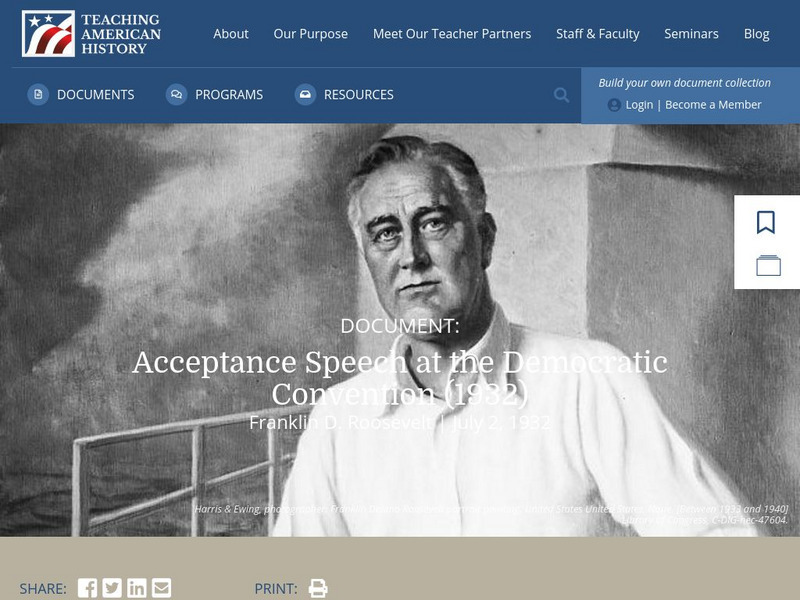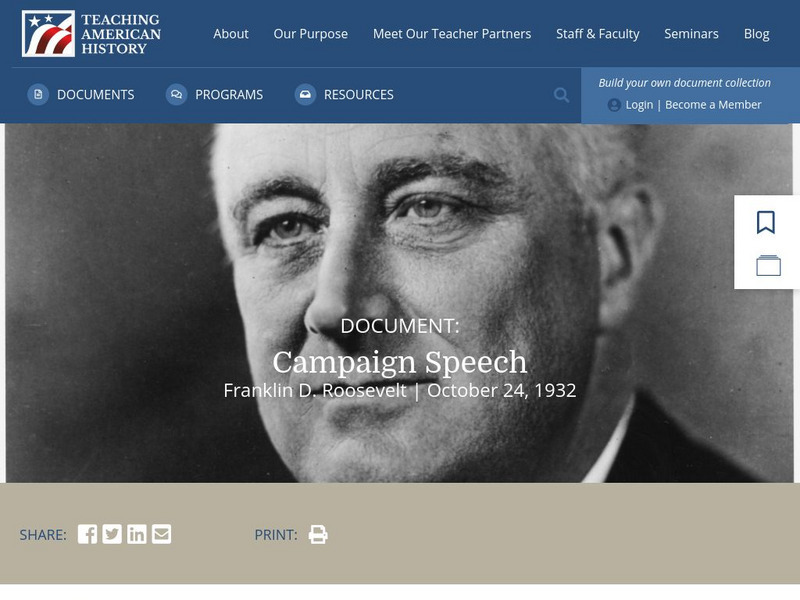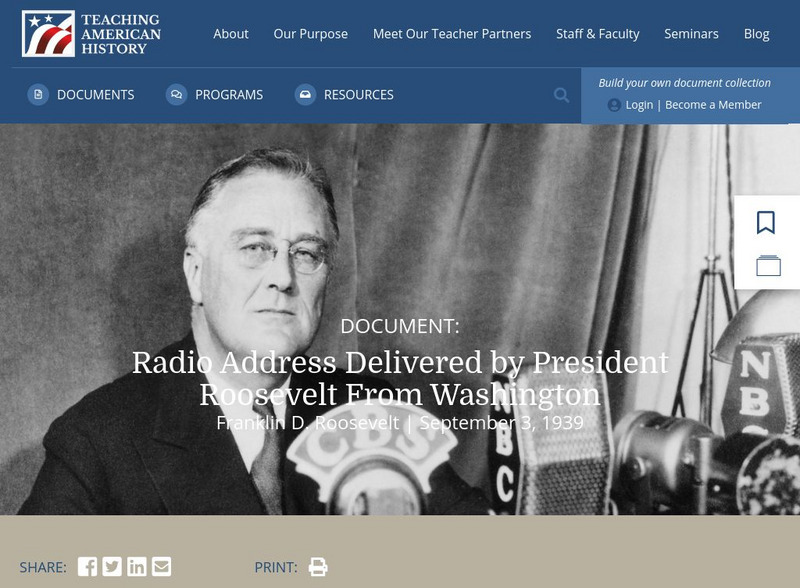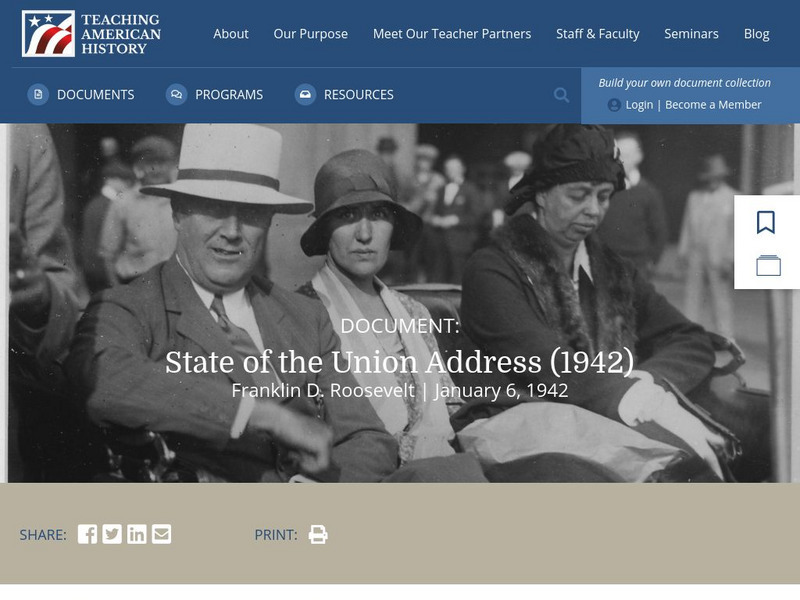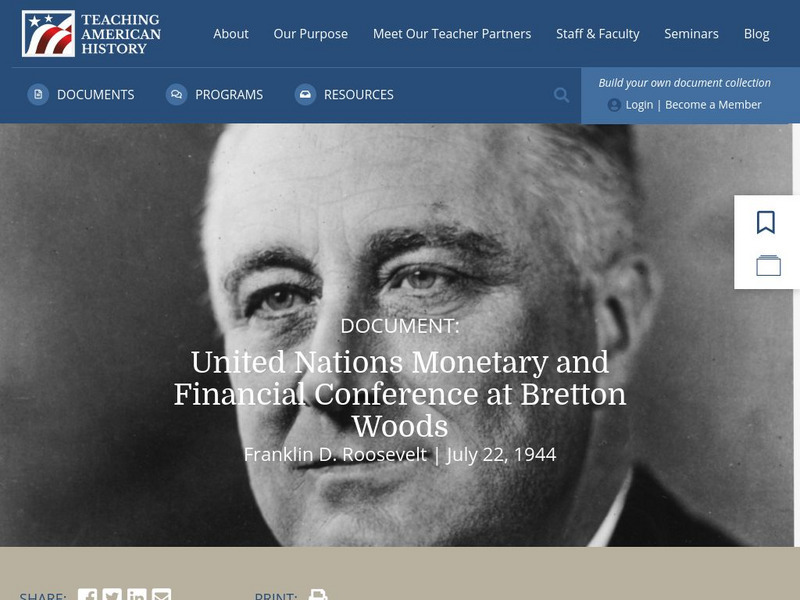Teaching American History
Interpretation of the Declaration of Independence
Ready to interpret the Declaration of Independence and understand its meaning? The resource divides scholars into pairs, where they work as a team to match translations with excerpts from the declaration. The class then engages in...
Teaching American History
A Word Fitly Spoken: Lincoln's Most Famous Speeches on Union
Abraham Lincoln's words carried American democracy through one of its most tenuous and violent moments in the nation's short history. Explore an interactive timeline that places events of the 19th century in the context of Lincoln's...
Teaching American History
Teaching American History: Bill of Rights Introduction
What is the Bill of Rights? Why were they created? Find out the purpose of these ten amendments to the U.S. Constitution and how they work to protect the citizens in the U.S.
Teaching American History
Teaching American History: Documents on the Grand Alliance
A collection of transcripts from meetings between the United States, the Soviet Union, and Great Britain during World War II in their efforts to defeat Germany and Japan.
Teaching American History
Teaching American History: Progressive Platform of 1912
Find the document outlining the platform of the Bull Moose Party. It explains why it has become a third-party contender and discusses the many progressive planks of the party for the election of 1912. It interestingly advocated a single...
Teaching American History
Teaching American History: Malcolm X: "Message to Grassroots"
This is the text of Malcolm X's speech "Message to Grassroots" delivered November 10, 1963.
Teaching American History
Teaching American History: Manifesto: American Anti Slavery Society
Find the goals of the American Anti-Slavery Society, founded in 1833 by abolitionists in Philadelphia. The object of the group was the immediate abolition of slavery.
Teaching American History
Teaching American History: Fdr: Acceptance Speech at the Democratic Convention
A transcript of the acceptance speech given by Franklin D. Roosevelt at the 1932 Democratic Convention.
Teaching American History
Teaching American History: Commonwealth Club Address
An address by Franklin D. Roosevelt in 1932 was delivered to win over the American people on the premise of economic security during the tremendous strife brought about by the Great Depression.
Teaching American History
Teaching American History: Franklin D. Roosevelt: Campaign Speech
FDR delivers a campaign speech as Election Day draws near in 1932. He addresses domestic issues that must be addressed as the nation experiences the impact of the Great Depression.
Teaching American History
Teaching American History: Letter to Franklin D. Roosevelt
Criticism from Herbert Hoover to President Roosevelt was sent in a private letter. Hoover offered suggestions for the president to help reassure the people of the United States during a time of great fear and desolation.
Teaching American History
Teaching American History: Franklin D. Roosevelt: First Inaugural Address
Transcribed version of the First Inaugural Address given by FDR in 1933.
Teaching American History
Teaching American History: Franklin D. Roosevelt: First Inaugural Address
Transcribed excerpts of President Roosevelt's First Inaugural Address delivered March 4, 1933.
Teaching American History
Teaching American History: Fireside Chat on the New Deal
Excerpts from Franklin Roosevelt's delivery of the May 7, 1933 Fireside Chat highlighting the purpose and goals of the New Deal.
Teaching American History
Teaching American History: Franklin D. Roosevelt: State of the Union 1934
Franklin Roosevelt's State of the Union address to the nation in 1934. This was the first "State of the Union" delivered.
Teaching American History
Teaching American History: State of the Union Address 1935
President Franklin D. Roosevelt's State of the Union Address delivered in 1935.
Teaching American History
Teaching American History: A Radio Address to the Democratic Clubs of America
On July 24, 1935, President Franklin D. Roosevelt delivered this radio address. He urges to keep the principles of America in the forefront and begs participation of the younger citizens to involve themselves in the decisions.
Teaching American History
Teaching American History: Fireside Chat: Plan for Reorganization of Judiciary
Franklin D. Roosevelt introduces a movement to reorganize the judiciary system of the United States during his March 9, 1937 Fireside Chat. He proposes to change the number of judges and the terms of their services to best uphold the...
Teaching American History
Teaching American History: Quarantine Speech
Franklin D. Roosevelt's speech to the American people pleading that the people understand and support the desperate desire for peace in the world and to isolate the country from the aggressive nations in October, 1937.
Teaching American History
Teaching American History: State of the Union Address 1938
A transcribed version of the State of the Union delivered by Franklin D. Roosevelt on January 3, 1938.
Teaching American History
Teaching American History: Fdr: Radio Address Delivered From Washington
A transcript of a radio address delivered from Franklin D. Roosevelt from Washington telling the nation that he hopes that the United States will not enter the war in Europe.
Teaching American History
Teaching American History: Atlantic Charter
Winston Churchhill and Franklin D. Roosevelt combine forces to communicate common principles both nations will pursue in an effort to influence a more peaceful world. The Atlantic Charter was released in August 1941.
Teaching American History
Teaching American History: State of the Union Address 1942
Franklin D. Roosevelt's State of the Union Address to the nation in January 1942.
Teaching American History
Teaching American History: United Nations Conference at Bretton Woods
A summary of the agreements created by the United Nations in the summer of 1944 concerning foreign trade and banking.








